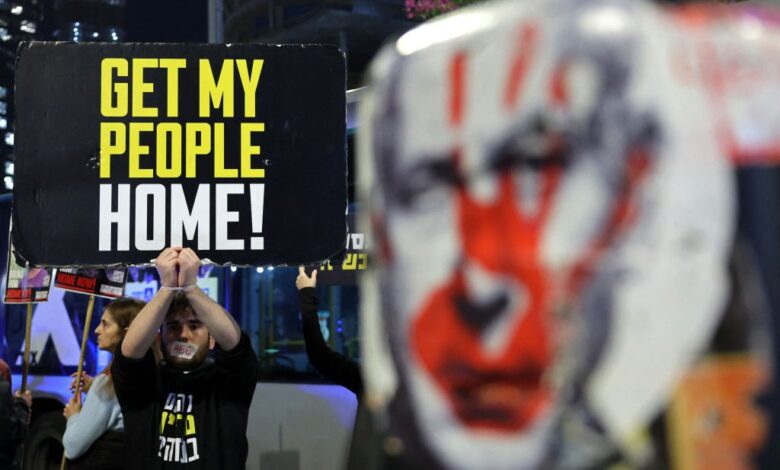What a Hostage Deal Means for Netanyahu’s Fate

For 467 days, millions of Israelis were yearning for Wednesday’s announcement that Israel and Hamas reached a ceasefire and hostage release deal. The agreement is expected to see 33 Israelis in Gaza freed in the first 42-day phase, which starts on Sunday. The rest will follow if a permanent end to the fighting comes in the second phase. The news was the first sign of hope in over 13 months, since the only brief ceasefire to date ended in December 2023, when nearly half of the hostages Hamas kidnapped on Oct. 7 returned home.
Yet there were no fireworks in Israel on Wednesday evening. Two hours after the news broke, Israeli volunteers in Hostage Square—the Tel Aviv plaza that has become a de facto encampment for hostage vigils, installations, and demonstrations—looked relieved but strained. “All the happiness is also sadness; it’s not even happy,” said Arnon Cohen, who grew up in Nahal Oz, a kibbutz near Gaza that was among the hardest hit on Oct. 7.
Cohen sat in a tent with a small group of his childhood friends, now in their late 40s and early 50s, who spoke of relief, anticipation, fear, exhaustion, and confusion. Would the first batch of hostages include their loved ones? Which ones are no longer alive, and will the second phase, with further hostage release, ever materialize? No one knows.
Read More: Parents of Slain Hostages Know ‘Deals’ Are Precarious
But one person in Israel should have been very pleased: Prime Minister Benjamin Netanyahu. After Hamas committed the most disastrous attack in Israel’s history on his watch, killing 1,200 people and kidnapping some 250 more, his public standing looked ruined. His approval ratings tanked. But by April 2024, those figures began to creep back up as Israel and Iran traded fire and Tel Aviv went on the offensive against Hezbollah. For Israelis, success on the battlefield restored a sense of strength, and Netanyahu reaped the credit.
Also, for a second time in his career, he outlasted a Democratic U.S. President that Israelis were told was insufficiently indulgent of Israel, and was rewarded with the November victory of Donald Trump, who Israelis resoundingly support in surveys.
Yet the public remained furious over the hostages left in Gaza. With each agonizing wave of failed negotiations over their release, they increasingly blamed Netanyahu for avoiding a deal. Daily vigils and Saturday evening demonstrations around the country grew large. Posters of the missing and “Bring them Home” slogans and symbols became ubiquitous, with yellow pins adorning lapels everywhere. “Now!” transformed into a national call, and doubled as a bitter anti-government epithet.
A deal should be a political win for Netanyahu. But he does not seem pleased. The agreement announced on Wednesday closely tracks the one hammered out last May by the Biden team, which Netanyahu steadfastly avoided, to be sure with help from Hamas. For days, he tried everything. He denied that specific points of agreement had been reached. He hedged on the finality of the deal. He accused Hamas of reneging on details. He dramatically postponed the government’s obligatory vote on the agreement. Then, finally, he confirmed on Friday the deal would go ahead.
The problem for Netanyahu is Netanyahu. Consumed by the desire to stay in power, he has been wedged between overwhelming public demand for the hostages to be released, and those who keep him in power—his coalition partners.
These partners include a fanatic coterie of ministers from the Religious Zionist and Jewish Power parties. They would rather die—more accurately, they would rather hostages, soldiers, and Palestinians die—than lose the opportunity to conquer Gaza and rebuild settlements, which they cannot do if the war ends. The West Bank is already almost annexed. Israel is occupying sovereign territory in Syria that might meet the same fate.
Netanyahu managed to seal his eyes, ears, and conscience against Israelis begging for mercy for their loved ones in Gaza all year, to keep these ministers at his side. He’s also not fundamentally opposed to their agenda; it was Netanyahu who engineered these parties’ electoral success and their prominent role in his government.
Enter Trump, the one person who both has leverage over Netanyahu (like every U.S. President) and seems willing to use it. Trump apparently turned up the heat for a ceasefire deal, and Netanyahu faced a new source of pressure.
Read More: A Gaza Ceasefire Is Here. Why Did It Take So Long?
Netanyahu now stands to win a spike in public support as hostages come home. But it’s the second phase of the deal—a permanent end to the war in Gaza—that his coalition partners find intolerable. Maybe at that point they will topple the government.
But it’s never quite over for Netanyahu, who always seems to have an escape route. The deal is extremely precarious and each phase is conditional on the previous one. But he may be tempted to see it through. Trump might conceivably bring a Saudi normalization deal, perhaps a green light to annex some settlements in the West Bank, or a freer hand against Iran.
In such a case Netanyahu could both reap some gain from the public for getting back hostages, while shoring up his base and political partners and coast along until the next scheduled elections in 2026.
The only certainty is that Netanyahu cares far more about his own political calculus than he ever cared about the hostages—or any victim of this war.
https://api.time.com/wp-content/uploads/2025/01/GettyImages-2193342590.jpg?quality=85&w=1024&h=628&crop=1
2025-01-17 06:37:11




